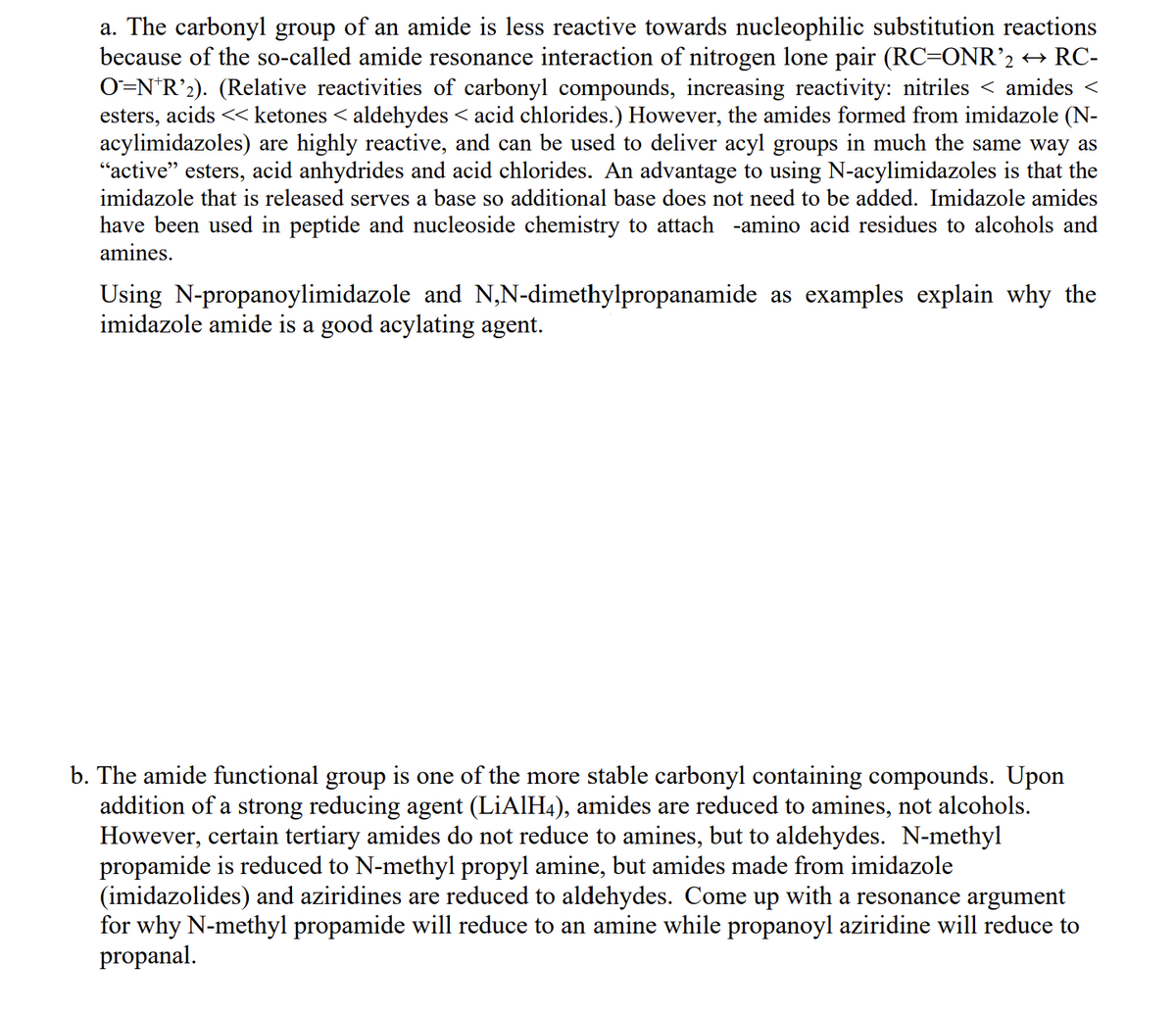a. The carbonyl group of an amide is less reactive towards nucleophilic substitution reactions because of the so-called amide resonance interaction of nitrogen lone pair (RC=ONR’2 → RC- ON R2). (Relative reactivities of carbonyl compounds, increasing reactivity: nitriles < amides < esters, acids << ketones < aldehydes < acid chlorides.) However, the amides formed from imidazole (N- acylimidazoles) are highly reactive, and can be used to deliver acyl groups in much the same way as "active" esters, acid anhydrides and acid chlorides. An advantage to using N-acylimidazoles is that the imidazole that is released serves a base so additional base does not need to be added. Imidazole amides have been used in peptide and nucleoside chemistry to attach -amino acid residues to alcohols and amines. Using N-propanoylimidazole and N,N-dimethylpropanamide as examples explain why the imidazole amide is a good acylating agent.
a. The carbonyl group of an amide is less reactive towards nucleophilic substitution reactions because of the so-called amide resonance interaction of nitrogen lone pair (RC=ONR’2 → RC- ON R2). (Relative reactivities of carbonyl compounds, increasing reactivity: nitriles < amides < esters, acids << ketones < aldehydes < acid chlorides.) However, the amides formed from imidazole (N- acylimidazoles) are highly reactive, and can be used to deliver acyl groups in much the same way as "active" esters, acid anhydrides and acid chlorides. An advantage to using N-acylimidazoles is that the imidazole that is released serves a base so additional base does not need to be added. Imidazole amides have been used in peptide and nucleoside chemistry to attach -amino acid residues to alcohols and amines. Using N-propanoylimidazole and N,N-dimethylpropanamide as examples explain why the imidazole amide is a good acylating agent.
Organic Chemistry: A Guided Inquiry
2nd Edition
ISBN:9780618974122
Author:Andrei Straumanis
Publisher:Andrei Straumanis
Chapter8: Addition Via Carbocation
Section: Chapter Questions
Problem 32CTQ: The hydration above is one of a family of reactions called electrophilic addition reactions.Explain...
Related questions
Question
please help with part B:

Transcribed Image Text:a. The carbonyl group of an amide is less reactive towards nucleophilic substitution reactions
because of the so-called amide resonance interaction of nitrogen lone pair (RC=ONR’2 → RC-
O=NR2). (Relative reactivities of carbonyl compounds, increasing reactivity: nitriles < amides <
esters, acids << ketones < aldehydes < acid chlorides.) However, the amides formed from imidazole (N-
acylimidazoles) are highly reactive, and can be used to deliver acyl groups in much the same way as
"active" esters, acid anhydrides and acid chlorides. An advantage to using N-acylimidazoles is that the
imidazole that is released serves a base so additional base does not need to be added. Imidazole amides
have been used in peptide and nucleoside chemistry to attach -amino acid residues to alcohols and
amines.
Using N-propanoylimidazole and N,N-dimethylpropanamide as examples explain why the
imidazole amide is a good acylating agent.
b. The amide functional group is one of the more stable carbonyl containing compounds. Upon
addition of a strong reducing agent (LiAlH4), amides are reduced to amines, not alcohols.
However, certain tertiary amides do not reduce to amines, but to aldehydes. N-methyl
propamide is reduced to N-methyl propyl amine, but amides made from imidazole
(imidazolides) and aziridines are reduced to aldehydes. Come up with a resonance argument
for why N-methyl propamide will reduce to an amine while propanoyl aziridine will reduce to
propanal.
Expert Solution
This question has been solved!
Explore an expertly crafted, step-by-step solution for a thorough understanding of key concepts.
Step by step
Solved in 3 steps with 3 images

Knowledge Booster
Learn more about
Need a deep-dive on the concept behind this application? Look no further. Learn more about this topic, chemistry and related others by exploring similar questions and additional content below.Recommended textbooks for you

Organic Chemistry: A Guided Inquiry
Chemistry
ISBN:
9780618974122
Author:
Andrei Straumanis
Publisher:
Cengage Learning

EBK A SMALL SCALE APPROACH TO ORGANIC L
Chemistry
ISBN:
9781305446021
Author:
Lampman
Publisher:
CENGAGE LEARNING - CONSIGNMENT

Organic Chemistry: A Guided Inquiry
Chemistry
ISBN:
9780618974122
Author:
Andrei Straumanis
Publisher:
Cengage Learning

EBK A SMALL SCALE APPROACH TO ORGANIC L
Chemistry
ISBN:
9781305446021
Author:
Lampman
Publisher:
CENGAGE LEARNING - CONSIGNMENT